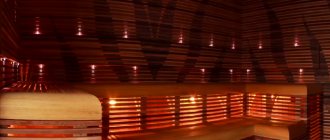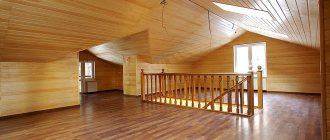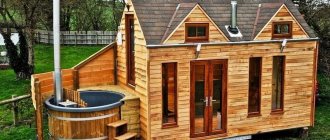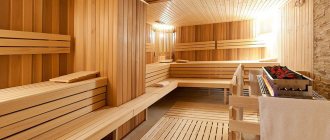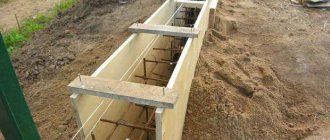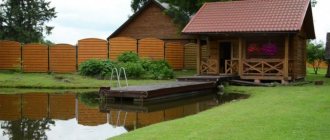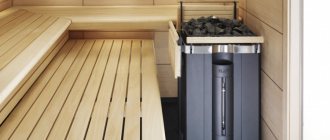For our compatriots, the Russian bathhouse is a symbol of relaxation. In addition to its medicinal properties, you can have a good time with friends and talk about pressing topics in a relaxed atmosphere. If you like this kind of pastime, then you can build it on your site, but in this case you need to know well the structure of the steam room in a Russian bath. This is exactly what we will be discussing in this article.
The steam room is the heart of the bathhouse; the mood its visitors will receive will depend on it. The peculiarity of the Russian bath in question is that it has a different quality of steam and temperature compared to others. For example, if in a Finnish sauna there is dry steam with a temperature of about 110 degrees and humidity only 15%, then in a Russian sauna the temperature is 60 with the same humidity.
The principle of operation of a Russian bath
Correct temperature and humidity
As for how hot to fry the stove and pour water in a Russian bath, it depends only on individual sensations.
People with poor health and a low pain threshold can get burned from water with a temperature of 60°C, but a healthy group of men can easily heat stones white-hot and then swim in an ice hole. For example, Finnish researchers proved several decades ago that the most comfortable temperature range for a bath is between 40-65°C, and relative humidity is 40-60%. Which is exactly what concerns the Russian steam room!
Although some Russian lovers consider a bathhouse not a bathhouse if the temperature in it is less than 100°C. This is extreme sports that are life-threatening and often end in cancer. Here it is simply necessary to include logic: if in fact such a bath was useful and pleasant, it would have been practiced thousands of years ago. Therefore, the correct microclimate of a Russian bath should be like this:
Features of installing a water tank
One of the important decisions is the choice of how the steam room will be used, or more precisely, what kind of steam is planned in it - dry or wet. If it must be wet, then a Russian bathhouse will be required. To do this, install a tank of water in the steam room, which will significantly increase the humidity level in the room.
If preference is given to dry procedures, then the tank should be placed in the next room and connected to the stove using a heat exchanger.
Indications and contraindications for the use of RBM
Banya Maslova can cure many diseases with the right approach. Indications for using such a bath are:
- chronic heart disease;
- hypertension in the initial stage;
- bronchitis and pneumonia;
- epilepsy, various neuroses and depression;
- problems in the endocrine system;
- allergies of various types;
- stomach ulcer.
In addition, regular visits to the RBM are recommended for immunocompromised children and pregnant women. Bath procedures with uniform heating of the whole body help get rid of toxicosis, fetal hypoxia, and help reduce blood loss during childbirth.
Child in Banya Maslova
Of course, in order to be completely cured, it takes time and patience; under no circumstances should you abuse the bathhouse or stay in it longer than prescribed.
Particular attention should be paid to contraindications, otherwise, instead of improving your health, you will get a completely opposite result.
Spa treatments at Maslova Bathhouse
Contraindications:
- all types of acute infectious diseases;
- sharp exacerbations of inflammatory processes;
- problems with cerebral circulation;
- heart attack and related conditions;
- renal failure;
- third stage hypertension.
Proper use of the Maslova bath will help restore tone, gain energy and simply enjoy life.
Bathhouse decoration with mosaics
General information about the steam room
The steam room is operated in conditions of high temperature and humidity.
The steam room is heated hotly, and hygienic water procedures are carried out in it. Visitors wash by warming up the body in hot air, while the volume of warm water used is limited.
Pairs are divided into types:
- sweat;
- gang;
- steam.
A sweat room is a room where people purify themselves by sweating. After heating and sweating, the visitor rubs the skin, whips the body with a broom, and rubs it with hair sponges. Standard Finnish saunas also belong to this type.
Chain (washing) baths are distinguished by the technology of washing in a hot room. The liquid is poured into small vessels, for example, troughs, basins, gangs, barrels. To wash the body, use soap and alkaline agents. After dousing it becomes cold, so the air in the room is heated to high temperatures.
Steam baths are distinguished by the fact that washing occurs when condensation appears on the skin due to high humidity and steam. Evaporation in the form of bath mist and smoky clouds is obtained by pouring water on hot stones.
Wood for bath walls
Thanks to modern technologies, a variety of wall materials can be used when building a bathhouse. Most often they are built from wood, and this has been happening for many centuries. Usually cylindrical logs or beams are chosen. The latter option is more convenient to use and weighs less.
Advantages of wood:
- Low thermal conductivity. When deciding how to set up a steam room in a Russian bathhouse, many choose this material (read: “How to make a steam room in a bathhouse correctly and beautifully”).
- Ecological cleanliness.
- Pleasant aroma of natural wood.
- Strength.
- Aesthetic appearance.
Recommendations for choosing material
Followers of traditions are recommended to build a bathhouse from high-quality coniferous wood. This material is not fragile, and most importantly, it lasts a long time. The needles are also distinguished by their environmental cleanliness and low thermal conductivity, that is, they do not release heat and at the same time interfere with air exchange. A unique property of this tree is its resistance to various climate conditions.
Such a wooden building must stand on a reliable foundation
For construction, you can take one of two types of coniferous wood:
- rounded round logs;
- solid beams.
Experienced builders advise building a bathhouse from beams, since this material is cheaper and it is much easier to build walls from it. In addition, timber construction works well without a bulky foundation.
The timber structure looks simple, but is easy to assemble
If you opt for rounded logs, you may be severely disappointed: a log structure takes a long time to settle, which is why it will not be possible to put it into operation earlier than a year and a half after construction. Unlike a log bathhouse, a timber structure can be safely used six months after the completion of construction work.
When purchasing beams, you should use a tape measure to check the material for compliance with the specified dimensions, and then make sure that the building materials are of good quality. To do this you need to do the following:
- visually examine the material and remove defects from the prepared batch, that is, bars whose color is uneven or unnatural and indicates poor drying of the product;
- see if there are any building materials with large cracks, bluish spots, wormholes or other damage among the beams, and put them aside;
Every beam needs inspection
- pay attention to the edges of the material and make sure that the growth rings on both sides are exactly the same in size.
Peculiarities
The wood-heated steam room is a rustic classic, proven over hundreds of years. This is a traditional type of Finnish and Russian bathhouse. All other types of structures, for example, the Turkish hammam, mainly use other combustion materials (coal or dung).
A bathhouse, as a rule, has one or two main rooms - the steam room itself and the dressing room. The latter is used to undress and dress. In former times, this room was not heated and had no windows; it was equipped only with a bench. Nowadays, people are accustomed to comfort, so dressing rooms not only serve as locker rooms, but also become a full-fledged recreation area - they are made spacious and equipped with tables, shelving and other interior items.
That is why today a wood-burning bathhouse is much more than just a place for taking hygiene procedures, it is a full-fledged room for cozy gatherings with family and friends, as well as an indicator of the status of its owner - not every one of our compatriots can afford a cozy and multifunctional steam room .
This design has many advantages:
- The wood-burning sauna is considered part of the culture and traditions of many peoples and nationalities.
- The principle of its operation does not require electricity, gas pipelines or other additional utilities.
- Wood is considered a cheap and accessible fuel option.
- The traditional Russian steam room is the simplest device in a technological sense - since when using, for example, an electric stove, you cannot splash water on hot stones, as is customary in traditional bath complexes.
- Wood can be stored for quite a long time, so once you have prepared firewood, you can use it for a very long time.
- If the room has a steam room combined with a washing room, then they can be heated from the same stove.
- Firewood is more environmentally friendly than fuel oil or coal, since the latter, with prolonged use, begin to smoke and emit an unpleasant odor, which makes staying in the steam room quite unpleasant.
However, nothing ideal has yet been invented, so a wood-burning sauna also has some disadvantages, namely:
- A wood-heated bathhouse may not be built everywhere—stove heating is prohibited in many areas.
- The Finnish sauna is inferior to an electric heater in terms of ease of use.
- Firewood for heating water is less economical than modern gas water heaters.
- Wood requires a specially designated place for storage, and in addition, if the woodpile is not sufficiently protected from moisture, the workpieces may begin to rot and collapse.
- The air temperature in the steam room is quite difficult to control - it is determined solely by the personal feelings of the person who is preparing the bath for use. For comparison, electric firebox options allow you to set the required temperature with an accuracy of 1 degree and change it as needed.
Arrangement of a bathhouse - why is it important
What is more important to you in a bathhouse - good steam or the visual appeal of the interior decoration? Everyone has their own answer. Some will be satisfied with the unpretentious, spartan look of a bathhouse built from high-quality materials. There will also be those who want to bring comfort. Everyone is right, and every component of the bath cult is important.
In this review, the arrangement of a bathhouse will be considered mainly in terms of functional features. Therefore, first of all, it is worth noting that all optimization measures are aimed at creating a comfortable resting and washing area, as well as being able to achieve a stable high temperature in the steam room. To do this, during design and construction, not only the right types of wood must be selected, not only ventilation and air circulation must be intelligently arranged, but also the most comfortable layout must be thought out.
You can understand whether a bathhouse is well designed using your personal feelings. So, using the example of a steam room, when the construction technology is not followed, in a heated room after some time you may feel nauseous and a rapid heartbeat. Perhaps this method is subjective, but, you see, no one will put up with discomfort when taking bath procedures. Therefore, it is better to study many years of experience in advance, adhere to all the rules and avoid mistakes.
Bathhouse and the Russian army
The bathhouse played a significant role in the Russian army, especially during military campaigns. At the end of the 19th century in Russia, huge disputes broke out among army officials. They argued whether a soldier really needed a steam room, and whether it was time to replace camp baths with European showers. Inexpensive and aesthetically pleasing. The dispute was resolved by the doctor Mikhail Gusev, who was preparing to defend his Doctor of Medicine degree. Gusev recruited two groups of volunteers, forcing them to live according to a schedule for three months: eat at specified times, but most importantly, regularly visit the bathhouse. The experiment proved that the Russian bath is a powerful source of health. All the volunteers gained weight in three months and became physically stronger, but the main argument: not one of them “suffered even a mild illness.”
Finishing the room
Treat surfaces with linseed oil, special antiseptics and wax.
Sanded lumber is used in finishing the floors, walls, and in the construction of benches, so after installation it is enough to go over it with sandpaper. This is how to remove raised fibers that appeared during the process of working with wood. For finishing, compositions are used to add attractiveness and emphasize design elements.
Purchase natural-based products for treating wooden floors, walls, and benches. Painting is carried out with the steam room not working so that the products dry under natural conditions. Synthetic dyes and varnishes are not used for the steam room, as they release harmful substances.
Treat surfaces with linseed oil, special antiseptics and wax. Sometimes oil and wax are combined for better impregnation. Wait at least 12 hours between applying several layers to allow the product to absorb and dry.
Laying the foundation
Once you have decided on the size and location of the future bathhouse, you can begin the construction process. In most cases, a columnar or strip foundation is sufficient for its construction. The latter is durable and resistant to soil displacement, but it is more difficult to erect, it is more massive and requires more materials. The strip base is ideal for buildings made of brick or wood.
When building a Russian bathhouse with your own hands, you need to think about what kind of foundation you will need for it. In any of the options, you will need to dig trenches along the entire perimeter of the building, fill their bottom with a sand cushion, then water it and compact it thoroughly. When pouring a concrete layer, you need to ensure that the top level of the layer is above the zero level. The surface must be carefully leveled and supplemented with a waterproofing layer, for example, using roofing felt and bitumen mastic. The base must be strengthened with reinforcement.
If the building is compact and not too massive, you can choose a columnar foundation that will not put a strong load on the ground. In this option, the pillars are located in the corners of the future building, in places where the external and internal walls will intersect with each other, where there will be places of greatest load. Usually the distance between them is one and a half to two meters. The pillars are connected to each other by a grillage, which gives reliability to the base of the building. The surface of the base needs to be leveled and waterproofed, not forgetting to leave space for the base of the stove.
Columnar base
This type of foundation when installing a bathhouse allows you to save money. It can be done on different types of soil.
Advantages of a columnar base for a bathhouse:
- low cost of work is achieved due to the fact that there is no need to pour a foundation along the entire perimeter - columns are made only in certain places;
- There is the possibility of installation both in lowlands and on slopes, as well as in swampy areas.
The sequence of work is similar to how when creating a strip base with one difference - not the entire perimeter is filled, but only the holes prepared under the joints of the pit walls.
There is another, faster and more economical way to arrange a pile foundation:
- They make markings and dig holes in accordance with the diameter of the asbestos pipes.
- Pipes are inserted into the ground and concrete is poured into them.
Construction of a Russian bath
The Russian bathhouse is perhaps one of the most ancient structures, the design of which has survived to this day. When a peasant built a house, he began with a bathhouse. I lived in it for the first time. In villages, a bathhouse is most often a hut made of logs. We got along with such a good-quality log house without drawings. The logs were laid in crowns, i.e. horizontal rows. Wood, in addition to its indisputable, as builders say, technological qualities and, as hygienists note, biological advantages, has one thing, perhaps the most important. A thousand years of human attachment to him. The tree pleases with its appearance, aroma, and feeling of warmth. Awakens good emotions, which means it improves your health. It is no coincidence that, for example, in the famous Sandunovsky baths the steam room is lined with bog oak. Without a single metal nail! Everything is on oak tongues.
Often the bathhouse is half submerged in the ground. Or they even built dugout bathhouses. This bathhouse is the oldest. It can still be seen today in some villages.
A classic Russian bathhouse is a hut built from logs. First there is a small waiting room. Here they undress and after washing they “wash down the bath with kvass.” Then the steam room, where there is a stove with stones placed in it. Therefore, such a stove is called a heater. It’s better to heat it with birch logs - they burn hot and don’t give off sparks, which means there won’t be a fire. You can also heat the stove with aspen wood. Those baths in which smoke escapes through a chimney are called “white” baths. The shelves are made of three or four steps. The higher it is, the hotter it is. It, like the benches along the walls and the tubs, is best made from linden. They will add steam - the steam room smells of honey.
Siberians build their baths from cedar. A real Russian bathhouse is unpretentious, without unnecessary luxury or pomp. But, despite his modesty, he royally bestows health and strength. It was this kind of bathhouse that tempered the brave Siberian pioneers with its heat and freezing cold (from the bathhouse into the snowdrift).
There are different ways to heat water for washing. Most often, a cast iron boiler is placed directly into the sauna stove, in which the water is heated. The bathhouse is heated for more than one hour, which means the water boils and bubbles for a long time. Clouds of steam envelop the bathhouse. And excessive dampness is not in the traditions of the Russian bath
Therefore, it is important to ventilate the room
Baths where there is no pipe in the stove are called “black” baths. The smoke goes into the steam room, so the walls are smoked. After heating, such a bathhouse is ventilated and the walls are doused with water. Then they put several pieces into the heater and steam the bath.
The stones in the oven should not expand when heated. Therefore, when selecting them, you should remember that all natural stones, with the exception of sandstone, are able to withstand sudden changes in temperature. It is best to select round stones - they heat up evenly. The firebox is located in the dressing room, and the steam room itself is accessed by a door from the last chimney, the one where the cobblestones are located. This is the most economical stove.
You can read more about the design and construction of a bathhouse in the “Construction” section.
Insulation of the room
The foil material is attached with the reflective side towards the inside of the room.
It is better to insulate the steam room inside than to install an insulator outside. The peculiarities of the room are such that steam and high temperature must be kept in the room, and with external cladding, part of the energy is spent on heating the wall. Condensation that appears on vertical fences will lead to their deterioration and gradual destruction from rot.
Insulation used:
- mineral, stone wool, slag wool;
- foil foam, penoizol;
- extruded polystyrene foam.
Mineral wool quickly becomes saturated with moisture from condensation and steam, so its operation requires a counter-lattice to create ventilation. This design makes an already small room smaller. Foil material, which is not moisturized and has a small thickness, works more effectively.
A layer of foil reflects infrared rays into the steam room, but this matters if there is a stove in the room. Insulation is combined with waterproofing of the steam room. As an insulator, they use roofing felt, special vapor-permeable membranes, or use thick polyethylene.
From the steam room to the snowdrift?
Another national tradition of the Russian bathhouse is to jump from a hot steam room straight into a snowdrift, ice water, or at worst, wipe yourself with snow.
Foreign sauna lovers almost faint when they see such extremism. But in fact, such a massage with a sharp change in temperature has a fairly beneficial effect on the human circulatory system: the blood vessels become toned, metabolism is normalized, and the body’s resistance to colds is significantly increased. And most importantly, after such extreme procedures, your mood rises and additional strength appears.
Door installation
The door must close tightly and not let heat out.
Use doors made of wood, choose dense and durable species that will hold hinges and handles well.
Stages of door installation work:
- assembling the box, canvas;
- marking and inserting parts of hinges separately on the sash and sash;
- installing the box in the opening with spacers before foaming;
- hanging the canvas on hinges;
- foam trimming;
- installation of a vestibule, seals;
- fastening trims on both sides of the door.
In wooden buildings, when installing opening fillings, a casing is made, which prevents the door from warping along with the shrinkage of the bathhouse. This design works separately from the walls, so it is not rigidly attached to the ends. A T-shaped or C-shaped casing is made on the side surface; accordingly, matching elements are cut out at the ends of the walls.
Rules of soaring
Before visiting the bathhouse, it is not recommended to eat heavy food, much less drink alcohol. During bath procedures, thirst often arises, so you need to take something to drink with you: water, kvass, juice or fruit drink.
It is recommended to cover your head with a bath cap or towel; this is necessary to protect your hair from drying out. You need to steam in several sessions: the first should last no more than 5 minutes, this time is enough for the body to warm up. All other visits to the steam room can last as long as is comfortable for you. In between these procedures, it is recommended to rinse with cold water.
A bath broom is a must-have attribute when visiting a bathhouse. Different types of trees and shrubs are used to make it. The original Russian version is a birch broom; oak, linden, and nettle brooms are also in demand. Unusual options include brooms made from eucalyptus and coniferous trees. Each of them has its own special properties.
Preparing brooms is an entire art; you need to cut off the branches at a certain period, store them correctly and soak them correctly.
During steaming procedures, you don’t need to whip the broom hard; just lean it lightly against the body with gentle patting movements. This procedure improves blood circulation, helps remove waste and toxins from the body, deeply cleanses the body, fills it with useful substances and improves well-being.
Today, aromatic oils are often used. But they are not typical for a Russian bath. They simply weren’t seen as necessary: the wood from which the bathhouse was built and the brooms emitted pleasant aromas, they created the right atmosphere and had healing properties. Also popular was the brewing of herbal decoctions, which were used for bathing.
Another tradition, rooted in ancient times, is to run out of the steam room into the street and jump into a snowdrift. This procedure is beneficial for the body; a sharp jump in temperature improves blood circulation, tones blood vessels, normalizes metabolism and significantly increases human immunity. After it, people feel cheerful and full of energy.
Visiting a Russian bathhouse is a great way to have a good time, relax, and improve your health. After this procedure, a person feels as if he was born again. Therefore, do not refuse this type of relaxation, visit the bathhouse and relax.
Enjoy Your Bath!
Preparation of tools and materials
For the floor, beams with a cross section of 50 x 50 mm are prepared; boards are chosen with a thickness of 30 mm or more. If a pouring floor is installed, the elements should not contain grooves or tenons on the sides.
Racks of shelving with benches are made with a cross-section of 100 x 100 mm, load-bearing purlins are made of material 80 - 90 mm. For sitting, take boards from 30 mm thick, the pitch of the crossbars depends on this.
Use the tool:
- tape measure, level, plumb line, carpenter's square, marking pencil;
- drill, screwdriver;
- a hacksaw for wood, a sanding machine, an emery machine, a chisel, a plane;
- hammer with a metal and wooden head, pliers.
Use wood with low thermal conductivity to avoid getting burned. It is preferable to use larch, aspen, birch, and fir with high density and moisture resistance. Coniferous pine and spruce are not used for interior decoration and bath furniture, because resins are released, which the species contains in large quantities.
Internal device
At different times, various construction technologies were used, and with time and the improvement of tools and building elements, baths, along with steam rooms, also underwent changes. The very first one was a single room that combined all the functions; they washed and took a steam bath in it. Then the spaces become larger, the steam room and the washing room are separated, and separate places for changing clothes and rest appear. The first baths in Rus' were heated “black”. Due to the absence of pipes and other exit openings, with the exception of the door and windows, soot and smoke settled in the steam room itself, which gave it a black color.
The bathhouse is an important part of cultural and social life. That's how she was and remains to this day. This is not only a place intended for hygiene procedures, but also for communication and communication.
Requirements for the future bathhouse project
There cannot be just one correct bathhouse design. Planning requires an individual approach, since everyone has different preferences.
The most important thing you should pay attention to when choosing a project is that the bathhouse should have as few doors and turns as possible on the path from the steam room to the street. And for fire safety purposes, all doors in the bathhouse from the steam room to the street must open outward during evacuation.
What is the area of the bathhouse? This is the first question people ask when choosing a project. There is no clear answer. You need to take into account how many people it is designed for, the height of the tallest member of the family, whether you need a veranda, whether you are planning a plunge pool, a swimming pool, whether you want to organize a kitchen in the bathhouse, and maybe a second floor as a bedroom to accommodate guests.
Additional structures and rooms in the bathhouse
To increase the functionality of the bathhouse, equip:
- Polati. The ceiling can be redone. To do this, 30 mm tongue-and-groove boards are laid over the steam room and washing compartment. A ladder is mounted to them, and comfortable mattresses are laid on top. In the resulting place it will be possible to spend the night or partially accommodate vacationers in the bathhouse.
- Attic. When there are no other buildings on a suburban area, a good option would be to build a bathhouse with an attic floor, where a guest room, bedroom and kitchen would fit perfectly. As a result, a place will appear where there are conditions for living until a house is built. If there are a large number of vacationers, they can be placed in the attic room. Also on the second floor there is, for example, a billiard table. In the attic it is necessary to ensure high-quality ventilation, since in the summer it will be impossible to stay there when the stove is lit.
- Household block. It is a small extension where all the necessary communications are connected, including water supply and sewerage. Thanks to their presence, it is possible to place a bathroom here. This is especially convenient when children visit the steam room in winter.
- Kitchen. If a kitchen area is equipped, this will relieve pressure on the residential building.
Waiting room
Depending on the area, the dressing room may consist of a locker room or a fully equipped guest room.
Basic requirements for the premises:
- There should be 1.3 “squares” of space per person with a wall length of at least one meter.
- To reduce heat loss, window openings need to be made as small as possible.
- The following pieces of furniture should be installed - a table with chairs, hangers, shoe stands, etc.
The main purpose of the dressing room:
- Opportunity to change clothes and prepare for visiting the steam room.
- Availability of conditions for comfortable rest and communication after the procedures.
- Ensuring free movement during preparation for operation of the bathhouse.
Experts recommend, if there is sufficient square footage, to equip a recreation room by adding an extension to it with a swimming pool.
What should the lighting be like?
Windows in bathhouses should be made small to reduce heat loss. For a small steam room, the best option is blind windows measuring 50x50cm. In a large bathhouse, you can install thermally efficient double-glazed windows.
Electric lighting in the steam room should be dim so as not to spoil the relaxing atmosphere. It is better to make the light indirect. It is advisable to choose a lamp with a wooden lampshade that fits well into the design of the bathhouse.
The lighting device can be placed on the ceiling or wall from above and slightly behind, because Russians relax in the bathhouse, and the light should not blind the eyes. Lamps in the paired compartment must have stainless steel shades, and switches must be located outside the room.
Furnace installation
The fireplace doors lead into the dressing room.
Most often, the stove is connected to the steam room by a firebox channel, while the fireplace doors lead into the dressing room.
How to install a stove in a steam room with your own hands:
- make a foundation or a separate reinforced concrete base;
- a channel is formed in the wall adjacent to the steam room;
- the stove is installed so that there is at least 1.2 m to the ceiling;
- Place the smoke exhaust pipe vertically so that it does not touch the wooden parts of the ceiling.
The location for the stove is chosen so that in the steam room it is convenient to dismantle part of the wall under the channel without compromising the placement of stepped shelves. The foundation is finished on top with heat-resistant material, and a sheet of metal is placed on top.
Asbestos cement panels and foam glass are used. A sheet of iron is stuffed in front of the stove door so that it protrudes 10 cm beyond the stove on both sides. The channel in the wall leading to the steam room is lined with red brick.
How to build it yourself?
In most cases, you can build a bathhouse with your own hands. Any work begins with the construction of a foundation. For such buildings, columnar bases or strip structures are traditionally used. First you need to prepare a trench. Its parameters are determined individually in accordance with the building plan, the parameters of the weight and dimensions of the future bathhouse and the characteristics of the soil at the work site.
Then backfilling is carried out, while the installation technology involves the construction of a cushion of sand and crushed stone, followed by reinforcement of the foundation. At the third stage, concrete is poured. Pouring is carried out in horizontal layers, and each layer must be treated with a special vibrating tool, which will remove excess air. At the final stage of the work, the foundation is waterproofed; most often, roofing felt is used for this.
Even at the stage of foundation construction, it is necessary to take care of making holes for future utilities, since making holes in a finished foundation risks reducing the overall strength of the structure. A month after pouring the foundation, you can begin work on the construction of walls, while the general order of work largely depends on the type of base material used to build the frame.
By the way, frame construction is very popular these days, because the main structural elements are sold freely in ready-made form and the only thing a novice craftsman needs is to fix them on the foundation. The walls are built in accordance with existing plans and instructions, and at each stage of work the evenness of the structure should be checked.
At the final stage of construction, the roof is installed. The work order is as follows:
it is necessary to knock down the base of the roof from the bars; rafters are installed on the prepared base; the sheathing is fixed along the rafters, and it is important not to forget to leave a hole for the chimney; then all the required insulating materials are attached: vapor barrier, insulation, and then a film for waterproofing, and counter-lattice bars are nailed in, thanks to which the necessary gap is formed for effective ventilation of the under-roof space; and at the last stage he installs the roofing material directly; his choice is based on personal preferences. However, it is advisable to proceed from considerations of budget availability.
Building a bathhouse with your own hands
The next point in the step-by-step construction instructions for the construction of a bathhouse complex is the construction work itself.
The entire range of required construction work can be divided into several stages. The main stages of construction are the following:
- marking the construction site and preparing the site;
- laying the foundation;
- arrangement of the blind area;
- erection of walls of the bath complex;
- ceiling installation;
- assembly of load-bearing roof structures;
- installation of roofing material;
- installation of hydro-, steam- and thermal insulation;
- assembly of communications in premises;
- flooring;
- installation of finishing material.
It should be remembered that after the foundation has been erected, it must be given time to gain maximum strength. When using a strip foundation, the period for gaining maximum strength with a cement-concrete mortar is 28 days.
Before proceeding with the installation of walls, it is necessary to ensure that high-quality waterproofing is laid on the surface of the foundation between it and the first crown of the walls. High-quality waterproofing will significantly extend the service life of the bath complex building without major repairs.
After completing the installation of the building walls, the assembly and installation of load-bearing roof structures is carried out. Features of the load-bearing roof structure depend on the roof configuration.
When the roof is installed, installation of utilities and flooring in the premises begins; at the same stage, steam, hydro and thermal insulation is installed.
Written references to the bathhouse
According to chronicles of the 10th–13th centuries, the steam bath was widespread among the Eastern Slavs already in the 5th–6th centuries, which indicates their high culture. The ancient Slavs called the bathhouse “mov”, “movnya”, “movnitsa”, “mylnya”, “vlaznya” or simply “banya”. Confirmation of the widespread use of the bathhouse among the ancient Slavs is the chronicle message that one of the forms of tribute that one Slavic tribe paid to another was birch brooms.
The Arab scientist Ibn Dasta, traveling around Rus' in the 10th century, noted in his notes that Russians really like to take a steam bath, and then roll in the snow or swim in an ice hole. Ibn Dasta also reports that in villages, baths are dugouts that are also used as dwellings.
In the monument of Russian culture, in the chronicle work of Nestor “The Tale of Bygone Years” (945), in the part describing the legendary journey of the Apostle Andrew from Sinop to Rome through Kiev and Novgorod, there is a vivid image of the bath procedure in Veliky Novgorod: “... the sight of the bath ancient; and they will burn it with the lords, they will get together, and they will be Nazi and douse themselves with kvass, and they will take the young rod on everyone, they will fight themselves and they will finish it off when they come out alive, and they will douse themselves with cold water, and then they will come to life; and they do this all day long and torment them not in this way, but to torment themselves, and then they do it not for themselves, but torment.”
| "The Tale of Bygone Years" (945) | Nestor the Chronicler |
The bathhouse is mentioned in the treaty between Rus' and Byzantium (907), in which the Russians secure the right to use the bathhouse upon arrival in Constantinople: “...and let them do whatever they want.”
The “Tale of Bygone Years” describes the use of a bathhouse for the purpose of performing a cleansing ritual: “Olga commanded the villagers who came to perform a roaring ceremony: come to me, washed out. And the villagers climbed in and began to wash.”
Prince Vladimir the Great
In the charter of Grand Duke Vladimir (966), baths were called institutions for the infirm, which reflects a deep understanding of the bath as an effective therapeutic tool. The Nikon list tells that in 1019, Bishop Ephraim of Pereyaslavl, who later became the Metropolitan of Kiev, ordered the construction of “...baths and bath buildings and doctors and hospitals for all who come and free healing.” The doctor-monk of the Kiev-Pechersk Monastery Agapit healed the sick with herbs and a steam bath. It is interesting to note that according to the monastery regulations, patients being treated in the monastery hospital were supposed to be washed in a bathhouse twice a month.
The granddaughter of the Kyiv prince Vladimir Monomakh, Eupraxia (Zoya), the first Russian female doctor, spoke highly of the therapeutic effect of the steam bath: “... invigorates the body and cheers the soul.”
The Old Russian “Tale of Peter and Fevronia of Murom,” which belongs to the folklore of ancient Rus' at the beginning of the 13th century, well illustrates the leading role of the bathhouse in Old Russian folk empirical medicine and the nature of the original and often very effective medicinal remedies used in it. According to some copies of this story, the Murom prince Peter, who suffered from an incurable skin disease, was healed in the Ryazan land by the girl healer Fevronia, whose father and brother were beekeepers, i.e. They were engaged in extracting honey from wild bees in the forests. Having examined the prince’s “scabs and ulcers,” the healer ordered the bathhouse to be heated hot, the patient to be washed, and those parts of his body that “are supposed to be scabs and ulcers” to be anointed with honey from wild bees. As a result of this treatment, the sick prince recovered - his body became “healthy and smooth.”
| Prince Peter is anointed with a potion in the bathhouse | The healed Prince Peter sends gifts to Fevronia |
Stages of bathhouse construction
So, we decided on the project and size. We chose the place, location and materials for construction. Now about what needs to be done. And you need to do the following:
- Select the type of foundation and build it. You should also take into account the terrain, climate, soil type, weight and size of the bath.
- Raise the walls. The material has already been decided on based on preferences and capabilities.
- Build a roof and make a roof. The design and shape of the roof (single, gable or complex broken), as well as the type of roofing, must be planned in advance (metal tiles, flexible piece materials, and maybe exotic ones - roofing made of turf or reeds).
- Lay floors and ceilings.
- Install windows and doors. You need to know: how many, which ones, where to put them, which way they will open, sizes.
- Insulate the bathhouse (walls, floors, ceiling, attic - if any).
- Think over and install all communications (electrical, plumbing).
- Choose and install the stove wisely.
- Make interior and exterior decoration of the bathhouse (if required).
- Build shelves, benches and install the necessary furniture.
- Screw on the hooks and purchase various bath accessories.
Article on the topic: Is it possible to lay corrugated board along the fence?
That's all: we have completely decided what kind of bathhouse to build. Now you can start steaming...(just kidding).
Top secret
The first to notice the healing properties that the bath has on the human body were the Magi - the most advanced and educated part of the then pre-Christian society. It was they who began to practice the use of two key natural elements, fire and water, and additional ones - medicinal herbs, in their medical practice.
Moreover, there is reason to believe that already at that time such a thing as a physiological clock was known - a certain cycle of occurrence, activation or, conversely, attenuation of basic physiological processes. Unfortunately, the lion's share of the knowledge of that time was irretrievably lost, along with the departure from the historical scene of the pagan religion and its bearers. The basis of the pagan world was maximum unity with nature.
Preliminary steps
Before following the steps of our instructions, it would be better if you followed the links that lead to detailed articles - about the types of bathhouse foundations, types of building materials for walls and roofs.
Because otherwise, either the volume of this article would grow uncontrollably, or we would have to talk about everything too superficially. Here we will look at the basic steps in detail and touch a little on some additional aspects of working on your own to create your ideal steam room. For more detailed information, follow the links in the text.
If you don’t want to resort to the help of outsiders, find out what options there are for arranging the floor, walls and ceiling in the steam room, make your choice and get to work.
Rules for visiting the Finnish sauna
There are certain rules that must be followed when visiting a Finnish sauna.
- Before visiting the steam room, you should not wash with soap; just take a warm shower;
- Hair must be dry; you cannot wet it before the steam room;
- It is best to sit on the bottom shelf and try to relax as much as possible;
It is important to drink plenty of fluids;
